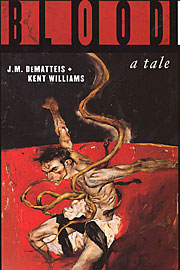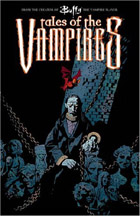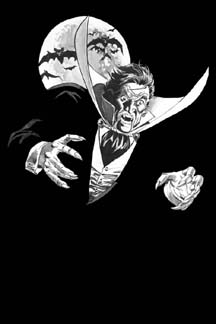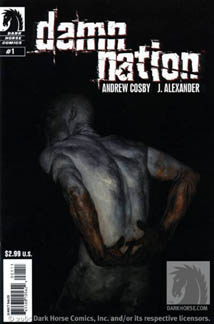 Welcome to week two of Thor’s Creature Comics Feature, the second in a three-part series which looks down the (recent) annals of Thor’s reviewing history to remind you of some of the best, the worst, and those inbetween comics which ever so conveniently fit the genres we’ve picked out. Just think of it as a "Clip Show" with additional features.
Welcome to week two of Thor’s Creature Comics Feature, the second in a three-part series which looks down the (recent) annals of Thor’s reviewing history to remind you of some of the best, the worst, and those inbetween comics which ever so conveniently fit the genres we’ve picked out. Just think of it as a "Clip Show" with additional features.
In continued celebration of our beloved Creature Comics Feature, Thor’s Comic Column and Oddgod Press present a wicked radical contest with loads of fabulous prizes. CLICK HERE for more details and the rules of entry. It’s quick and fun, and the prizes are to die for… NO! Not just to die for, but to die for, and then come back to life and suck the blood of another for. They’re that good. Enter now!
And without further ado and stabby pains to the neck, we present Thor’s Creature Comic Feature – Vampire Comics!
DeMatteis and Williams Engorge “Blood” with More Than Standard Genre Tropes
By Russell Paulette
 I feel a little unfortunate that I missed out on the days when Marvel had some health to their Epic line in the mid 1980s. Seems like the more and more I find out about the era, the more and more people are referring me to that line’s books. Vertigo’s been fairly aggressive about picking up some of the creator owned books from that line, especially considering how hand-in-glove some of that material is with that imprint. Following up on the success they’ve had recollecting JM DeMatteis and John J. Muth’s Moonshadow, Vertigo went ahead and collected DeMatteis and Kent Williams’s pairing on the twisted vampire fable, Blood.
I feel a little unfortunate that I missed out on the days when Marvel had some health to their Epic line in the mid 1980s. Seems like the more and more I find out about the era, the more and more people are referring me to that line’s books. Vertigo’s been fairly aggressive about picking up some of the creator owned books from that line, especially considering how hand-in-glove some of that material is with that imprint. Following up on the success they’ve had recollecting JM DeMatteis and John J. Muth’s Moonshadow, Vertigo went ahead and collected DeMatteis and Kent Williams’s pairing on the twisted vampire fable, Blood.
The big secret to some of JM DeMatteis’s work, particularly his creator owned stuff, is that if you’ve read one book, you’ve kinda read them all. This is less of a bad thing than you would assume since DeMatteis continually revisits themes of wholeness and universal harmony—and the variations one can spin on them are particularly infinite. That said, the parallels in tone and texture to Moonshadow can’t be denied and, if you’ve read that thicker graphic novel, then Blood will seem like treading familiar ground, only where the former has fantastic science-fantasy trappings, the latter steeps itself in dark mythic swamp waters.
Blood is the story of an orphaned boy taken in by a monks, lied to and abused, banished to a forest, met with countless foes, only to soon discover his true nature as a vampire. Then, he embarks on a quest, joined by a female vampire and a small floating midget, to seek concrete answers to ephemeral questions that linger in the periphery of his awareness. Sort of. It’s also the tale of a dying king who is told Blood’s tale. Who then dies. Then turns into a dove. Who turns into a star. Who turns into a dying king. On and on and on.
To try and describe Blood in purely plot terms would be folly, as its narrative—and its charm—works on fever-dream and folklore logic. It’s a fable, a tale, a yarn spun into existence for the sake of spinning, of telling, of being. Blood’s story is less of a specific quest than an allegory for self-actualization, and if all of this sounds considerably pretentious, that’s because it is—but, again, it’s part of the book’s charm.
When it comes right down to it, you either are enchanted with DeMatteis’ writing, or you’re turned off by it. If the ephemeral, highly spiritual nature of the tale turns you off, you can rest assured that the writing itself is considered, careful and well-crafted, and likewise the art from painter Kent Williams beautifully matches the sonorous words surrounding it. Williams has a light, watercolor touch with a deft attraction to the grotesque. He’s the kind of artist who can paint a horrifying scene with such a loving brush, that you’re drawn in without losing your shock or dismay. Admittedly, there are moments where the storytelling falls off the rails—a panel here or there seems like it should be significant, but looks more like a muddy mess than anything else—but the color choices and larger composition of the pages are more than beautiful enough to keep your attention.
In the end, I liked Blood particularly because it was an off-kilter vampire story. Less of the sitting-on-gargoyles-brooding-and-whining variety, DeMatteis tells his tale more like a tall tale, brimming with allegory and symbolism, begging the reader to suss out meaning and significance from the strange juxtaposition of details. Williams is the perfect artist to convey DeMatteis’ strange, fluid story logic, handling the non-sequiturs as well as he handles the more naturalistic, straightforward scenes. Not for everyone, Blood is the kind of vampire tale for readers interested in sinking their teeth into some juicier flesh.
FOUR OUT OF FIVE VIKINGS

Tales of the Vampires tpb
(Originally reviewed January 2, 2005 RIGHT HERE)
 “Whedon, along with other Buffy and Angel writers like Jane Espenson, Drew Goddard and Ben Edlund, aren’t done penning adventures of the cutest Vampire Slayer and the characters in her periphery. Tales of the Vampires is exactly that: a variety of brief tales interwoven with a story of young Watchers in training, brought before an imprisoned elder bloodsucker who spins the chronicles of the title.
“Whedon, along with other Buffy and Angel writers like Jane Espenson, Drew Goddard and Ben Edlund, aren’t done penning adventures of the cutest Vampire Slayer and the characters in her periphery. Tales of the Vampires is exactly that: a variety of brief tales interwoven with a story of young Watchers in training, brought before an imprisoned elder bloodsucker who spins the chronicles of the title.
“As with most anthologies, Tale of the Vampires is a bloody mixed bag. Sure there are different writers’ and artists’ takes on familiar characters – Angel fights his inner demons, Spike seeks kooky mate Drusilla on the streets of Prague, Buffy (with some Slayerettes in tow) has a post-finale reunion with Dracula – but I found the best stories to be Whedon’s interesting perspective of a social outcast (and his overarcing story that ties everything together)” – Dave
RATING: 
 Stoker’s Dracula #1
Stoker’s Dracula #1
(Originally reviewed RIGHT HERE)
“Roy Thomas originally set out to create the most faithful adaptation of “Dracula” in any medium and commandeered an already ongoing title in Dracula Lives to do it. Darn it if it isn’t the case. Stoker’s Dracula # 1 is 44 pages long (issues #5-8 of the original Dracula Lives) and Jonathon Harker still hasn’t left Castle Dracula. I had forgotten how moody the first few chapters of Stoker’s novel were….
“Thomas never did get to finish Stoker’s story back in 1974 as a promotion and other duties got in the way. Seems that his adaptation never left his mind and now he’s determined to finish what he started 30 years ago. So, can we recommend Stoker’s Dracula? Alas, no. The book looks great. The idea that a man can return to a passion from three decades prior is endearingly romantic. Honestly, there really is no better adaptation of the original novel to be found anywhere. But “Dracula,” as cool as he is, is pretty played out. He’s had his time in the sun (so to speak). Give the undead S.O.B. a break. Then again if your choices are between this and Coppola’s Bram Stoker’s Dracula, definitely go with this.” – Rob
RATING: 
 Damn Nation #1
Damn Nation #1
(Originally reviewed February 21, 2005 RIGHT HERE)
“There are a lot of things that writer Andrew Cosby does well with this issue – the great high concept, the intriguing characters, the brilliant pacing – but the thing that struck me the most (ironically) was his subtlety. Given that it can’t rely on shock and sound the way it can in television and film, horror is a genre where, with respect to comic books, less is more. Where the most successful writers don’t try to beat the reader over the head, but let their imagination run wild – terrify them with what they can’t see, but know is there. Cosby manages to do that by only giving the reader bits and pieces of information. He does it with short, but clever, lines of dialogue between seemingly random characters, and he does it with situational inferences. In many ways, we’re left to figure out exactly what’s going on for ourselves. But we know it’s undeniably bad – apocalyptic. It’s an interesting way to structure a narrative. It makes it a more realistic read.” – Sean
RATING: 
 Sea of Red #1 (Originally reviewed April 11, 2005 RIGHT HERE)
Sea of Red #1 (Originally reviewed April 11, 2005 RIGHT HERE)
“Good horror comic books are hard to come by, but Sea of Red does what any good horror comic must in order to be convincing – it gets under your skin and creeps you out. The tone is set very effectively right from the first page with our “protagonist,” a Spanish mariner named Marco Esperanza, strapped to the bow of ship, starving to death…at the bottom of the ocean. How he finds himself in that horrible, tortuous predicament is for you to find out. Suffice it to say though that it involves a cursed pirate ship and her…bloodthirsty crew. It’s an intimate read, in that the horror is very personal – focusing largely on Esperanza’s anguish and desperation, and the dark, tormented nature of the Black Galleon’s crew. But there’s a gritty high seas action sequence in the middle of the issue that mix things up and adds another dimension to the book. All in all, it’s about as well constructed and well paced a debut issue as you can hope for – establishing the characters and the backdrop in an exciting and intriguing way.” –Sean
RATING: 
Sea of Red #2 – (Originally reviewed May 8, 2005 RIGHT HERE)
“Vampires and pirates ("Vampirates") is like Reese’s Peanut Butter Cups, two great tastes that go great together, especially in this series’ first issue…. The second issue doesn’t build well upon the first, but is instead a bitter, bitter disappointment.
“The old-school menacing high-seas pirate adventure has given way to a "200 years later" scenario, as the Spaniard-turned-vampire that was left rotting at the bottom of the sea at the end of the first ish is rescued by a small submersible craft that contains a James Cameron spoof eager to get himself a fantastic new Imax film. Though he should have been insane after 200 years with nothing but fish to keep him company, the Spaniard is quite sensible all things considered (although he does manage to attack the Production Assistant before calming down). It’s a quirky second issue that bears little resemblance to the intensity and ingenuity of the first.” –Graig
 Spike: Old Times
Spike: Old Times
(Originally reviewed August 29, 2005 RIGHT HERE)
“Here (writer Peter) David takes the format of a television episode and runs with it. The issue starts out with a flashback to 1880 London to give us some background before flying us to modern times. Those who’ve seen more than a few episodes of Angel know that this is a common motif used as a cold opening many times.
“This plays like a lost episode of one of the shows. Or perhaps to a pilot for a Spike show of his own (heaven forbid, as I think it would ruin his second banana style comedy). David’s dialogue is spot-on. We get all the "bloody hell"s and "sod a dog”s we could wish for. The story works very well and I’d rank this as one of the better adaptations from live action entertainment to graphic page. The dark humor from the best episodes of Angel shines out of this book. Excellent work. I don’t really consider myself a Whedon fanatic, but I dare say I’ve derived more pleasure from his creations than I deserve. Spike: Old Times gives me just a little bit more.” – Rob
RATING: 
Tune in to next week’s extra, extra special Thor’s Creature Comics Feature… on Hallowe’en. Isn’t that spooky boys and girls (he said in his best Count Floyd voice… if only I could do mimic Dr. Tongue’s 3-D effect in writing as well…)? It will mostly be all new reviews and some minor clippy goodness, it will be… MONSTERS-a-plenty!
